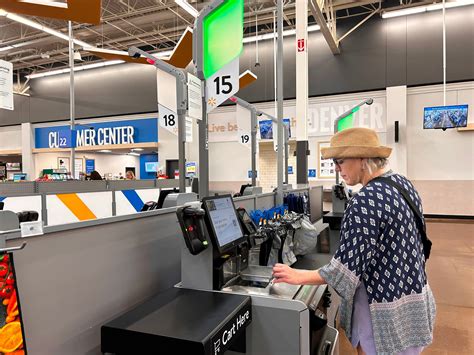
Walmart is reversing its self-checkout expansion in some stores, citing rising theft and losses, after police data revealed a significant increase in shoplifting incidents associated with the automated checkout lanes.
Walmart is implementing significant changes to its self-checkout policies across numerous stores, driven by a surge in theft and substantial financial losses. The retail giant is re-evaluating its reliance on self-checkout lanes after police data revealed a worrying correlation between the technology and increased shoplifting incidents. The move signifies a strategic shift for Walmart, prompted by the need to balance convenience with loss prevention.
The changes involve multiple approaches, including removing self-checkout lanes entirely in select locations, converting some self-checkout areas to “scan and go” setups where customers use handheld devices to scan items as they shop, and limiting the number of self-checkout lanes available during certain hours. The decision stems from growing concerns that self-checkout systems, while intended to enhance customer convenience and reduce labor costs, have inadvertently facilitated an environment conducive to theft.
“We’re always looking at ways to make the shopping experience better for our customers and associates,” Walmart said in a statement. “That includes adjusting staffing and checkout options.” While the company did not explicitly link the changes to theft, reports from various locations and police departments indicate a clear connection.
The implementation of these changes varies by location, reflecting Walmart’s commitment to tailoring solutions to the specific needs and challenges of individual stores. Stores experiencing higher rates of theft are more likely to see drastic changes, such as complete removal of self-checkout lanes, while those with lower incident rates may only experience adjustments to hours or the introduction of “scan and go” systems. This localized approach allows Walmart to address the issue effectively without implementing a blanket policy that could negatively impact stores with minimal theft problems.
Several police departments have reported significant increases in shoplifting incidents since the widespread adoption of self-checkout systems. Data indicates that while self-checkout lanes provide convenience for honest shoppers, they also create opportunities for theft, whether through intentional acts of shoplifting or unintentional errors. “It’s a mixed bag,” said one retail analyst. “Self-checkout can improve efficiency, but it also introduces new risks that retailers need to manage.”
The decision to modify self-checkout policies is not unique to Walmart. Other major retailers, including Target and Kroger, have also been experimenting with different self-checkout strategies in response to rising theft rates. These strategies include increasing staffing around self-checkout areas, implementing more sophisticated security measures such as advanced video analytics, and restricting the types of items that can be purchased through self-checkout. The collective action by these major retailers highlights the widespread concern over the effectiveness of self-checkout systems in preventing theft and the need for innovative solutions to mitigate losses.
Walmart’s move marks a significant reassessment of a technology once hailed as the future of retail. As the company navigates this transition, it will be closely monitoring the impact of the changes on both theft rates and customer satisfaction. The results of these experiments will likely influence the future of self-checkout technology in the retail industry as a whole. The company will continue to refine its approach based on real-world data and feedback, striving to strike the right balance between convenience, security, and customer experience.
The self-checkout U-turn underscores the complex challenges retailers face in the modern era, where technological advancements must be carefully balanced with the need for effective loss prevention measures. Walmart’s action is a response to tangible data and on-the-ground experience, signaling a broader industry trend toward a more cautious and nuanced approach to self-service technologies. The future of self-checkout remains uncertain, but it is clear that retailers are committed to finding solutions that protect their bottom lines while providing a positive shopping experience for their customers.
Detailed Breakdown and Context
Walmart’s decision to scale back its self-checkout operations represents a significant shift in strategy, prompted by escalating theft and substantial financial losses. The move reflects a broader industry-wide concern about the unintended consequences of self-checkout technology, which, while designed to enhance efficiency and customer satisfaction, has also created new avenues for shoplifting.
The Rise of Self-Checkout and Its Unintended Consequences
Self-checkout systems were initially introduced as a way to streamline the shopping experience, reduce wait times, and cut labor costs. The premise was simple: customers scan and bag their own items, pay at a kiosk, and leave the store. The technology promised to be a win-win for both retailers and consumers.
However, as self-checkout became more prevalent, so did reports of increased theft. Several factors contributed to this phenomenon:
- Reduced Supervision: Self-checkout lanes typically have less supervision than traditional cashier lanes, making it easier for shoplifters to conceal items or manipulate the system.
- Opportunity for Error: Some customers may unintentionally fail to scan items or mis-scan them, leading to unintentional losses.
- Psychological Factors: The impersonal nature of self-checkout may make some individuals feel less guilty about stealing, as they are not directly interacting with a cashier.
- System Vulnerabilities: Some self-checkout systems have vulnerabilities that can be exploited by sophisticated shoplifters.
Police Data and the Alarming Correlation
The decision to re-evaluate self-checkout policies was largely driven by police data indicating a significant increase in shoplifting incidents associated with the technology. While Walmart has not released specific figures, reports from various police departments paint a concerning picture.
In one instance, a local police department reported a 30% increase in shoplifting incidents at a Walmart store after the introduction of self-checkout lanes. Similar trends have been observed in other jurisdictions, prompting law enforcement agencies to work more closely with retailers to address the issue.
The data suggests that self-checkout lanes are not only facilitating intentional theft but also contributing to unintentional losses due to errors and omissions. This has led to a re-evaluation of the cost-benefit analysis of self-checkout technology, with retailers increasingly questioning whether the convenience and efficiency gains outweigh the associated losses.
Walmart’s Multi-Faceted Approach
In response to these challenges, Walmart is implementing a multi-faceted approach to address the issue of theft at self-checkout lanes. This includes:
- Removal of Self-Checkout Lanes: In some stores with particularly high theft rates, Walmart is removing self-checkout lanes altogether and replacing them with traditional cashier lanes.
- Conversion to “Scan and Go” Systems: In other locations, Walmart is converting self-checkout areas to “scan and go” systems. These systems allow customers to use handheld devices to scan items as they shop, reducing the potential for errors and theft at the checkout.
- Limiting Self-Checkout Hours: In some stores, Walmart is limiting the number of self-checkout lanes available during certain hours, particularly during periods of high traffic or low staffing.
- Increased Staffing and Monitoring: Walmart is also increasing staffing around self-checkout areas and implementing more sophisticated monitoring systems, such as advanced video analytics, to deter theft and identify suspicious behavior.
The Impact on Customer Experience
While the changes are primarily aimed at reducing theft, Walmart is also mindful of the potential impact on customer experience. The company recognizes that self-checkout lanes are popular among many shoppers who value the convenience and speed they offer.
To mitigate any negative impact, Walmart is focusing on providing a variety of checkout options to meet the needs of different customers. This includes maintaining traditional cashier lanes, expanding “scan and go” systems, and optimizing self-checkout lane availability based on store-specific data and customer feedback.
Walmart is also investing in training for its employees to ensure they can provide assistance to customers using self-checkout lanes and address any issues or concerns that may arise. The goal is to strike a balance between security and convenience, providing a positive shopping experience for all customers.
Industry-Wide Implications
Walmart’s decision to re-evaluate its self-checkout policies has significant implications for the retail industry as a whole. Other major retailers, including Target and Kroger, are also grappling with the issue of theft at self-checkout lanes and are experimenting with different strategies to address the problem.
The collective action by these major retailers highlights the widespread concern over the effectiveness of self-checkout systems in preventing theft and the need for innovative solutions to mitigate losses. As retailers continue to refine their self-checkout strategies, the future of this technology remains uncertain.
Some experts predict that self-checkout will eventually be replaced by more advanced technologies, such as computer vision systems that can automatically identify and scan items as customers place them in their carts. Others believe that self-checkout will continue to evolve, with retailers implementing more sophisticated security measures and training programs to reduce theft and improve the customer experience.
The Role of Technology in Loss Prevention
As retailers grapple with the challenges of theft and loss prevention, technology is playing an increasingly important role. In addition to self-checkout systems, retailers are investing in a variety of other technologies to combat theft, including:
- Electronic Article Surveillance (EAS): EAS systems use tags and sensors to detect when merchandise is being stolen.
- Closed-Circuit Television (CCTV): CCTV cameras provide real-time video surveillance of stores, allowing retailers to monitor customer behavior and identify suspicious activity.
- Advanced Video Analytics: Advanced video analytics software can automatically detect patterns of behavior that may indicate theft, such as customers lingering in certain areas or concealing merchandise.
- Radio Frequency Identification (RFID): RFID tags can be attached to merchandise to track inventory and prevent theft.
- Artificial Intelligence (AI): AI-powered systems can analyze data from various sources, such as CCTV cameras and point-of-sale systems, to identify patterns of theft and predict future incidents.
By leveraging these technologies, retailers can improve their ability to detect and prevent theft, reduce losses, and create a safer and more secure shopping environment for their customers.
The Importance of Employee Training
While technology plays a crucial role in loss prevention, it is not a substitute for well-trained employees. Employees who are properly trained in loss prevention techniques can be highly effective in deterring theft and identifying suspicious behavior.
Effective employee training programs should cover a variety of topics, including:
- Shoplifting Prevention: Techniques for deterring shoplifters, such as maintaining a visible presence, greeting customers, and offering assistance.
- Theft Detection: Identifying signs of shoplifting, such as customers concealing merchandise or acting suspiciously.
- Loss Prevention Policies and Procedures: Understanding the store’s policies and procedures for dealing with shoplifters and other security threats.
- Customer Service: Providing excellent customer service to deter theft and create a positive shopping environment.
- Safety and Security: Ensuring the safety and security of employees and customers.
By investing in employee training, retailers can empower their employees to play an active role in loss prevention and create a safer and more secure shopping environment for everyone.
The Broader Economic Context
The issue of theft in retail is not just a concern for retailers; it also has broader economic implications. Retail theft contributes to higher prices for consumers, reduced profits for businesses, and increased costs for law enforcement agencies.
According to the National Retail Federation, retail theft costs U.S. retailers billions of dollars each year. These losses are ultimately passed on to consumers in the form of higher prices.
In addition, retail theft can have a negative impact on local communities. When businesses suffer losses due to theft, they may be forced to reduce staff, cut back on investments, or even close their doors altogether. This can lead to job losses, reduced tax revenues, and a decline in the quality of life for residents.
Addressing the issue of retail theft requires a collaborative effort involving retailers, law enforcement agencies, policymakers, and the community as a whole. By working together, these stakeholders can develop effective strategies to deter theft, reduce losses, and create a more secure and prosperous environment for everyone.
FAQ Section
1. Why is Walmart changing its self-checkout policies?
Walmart is making changes to its self-checkout policies due to rising theft and associated financial losses. Police data has revealed a correlation between self-checkout lanes and increased shoplifting incidents, prompting the retailer to re-evaluate its approach to self-service checkout. The company aims to balance customer convenience with effective loss prevention measures.
2. What specific changes are being implemented at Walmart stores?
The changes vary by location but may include:
- Removal of Self-Checkout Lanes: Completely removing self-checkout lanes in stores with high theft rates.
- Conversion to “Scan and Go” Systems: Implementing systems where customers use handheld devices to scan items as they shop.
- Limited Self-Checkout Hours: Reducing the number of self-checkout lanes available during certain times.
- Increased Staffing and Monitoring: Adding more staff to supervise self-checkout areas and using advanced video analytics.
3. How will these changes affect Walmart customers?
The impact on customers will depend on the specific changes implemented at their local stores. While some may experience reduced convenience due to the removal of self-checkout lanes, others may benefit from the “scan and go” systems or increased staff assistance. Walmart aims to minimize any negative impact by offering a variety of checkout options and providing training to employees to assist customers.
4. Are other retailers making similar changes to their self-checkout policies?
Yes, other major retailers such as Target and Kroger are also experimenting with different self-checkout strategies in response to rising theft rates. These strategies include increasing staffing, implementing more sophisticated security measures, and restricting the types of items that can be purchased through self-checkout. The widespread concern highlights the need for innovative solutions to mitigate losses while maintaining customer convenience.
5. What is the long-term future of self-checkout technology in retail?
The future of self-checkout technology is uncertain. Some experts predict that it will be replaced by more advanced technologies like computer vision systems, while others believe that self-checkout will continue to evolve with more sophisticated security measures and training programs to reduce theft and improve the customer experience. Retailers will likely continue to refine their approaches based on real-world data and feedback, striving to find the right balance between convenience, security, and customer satisfaction.









